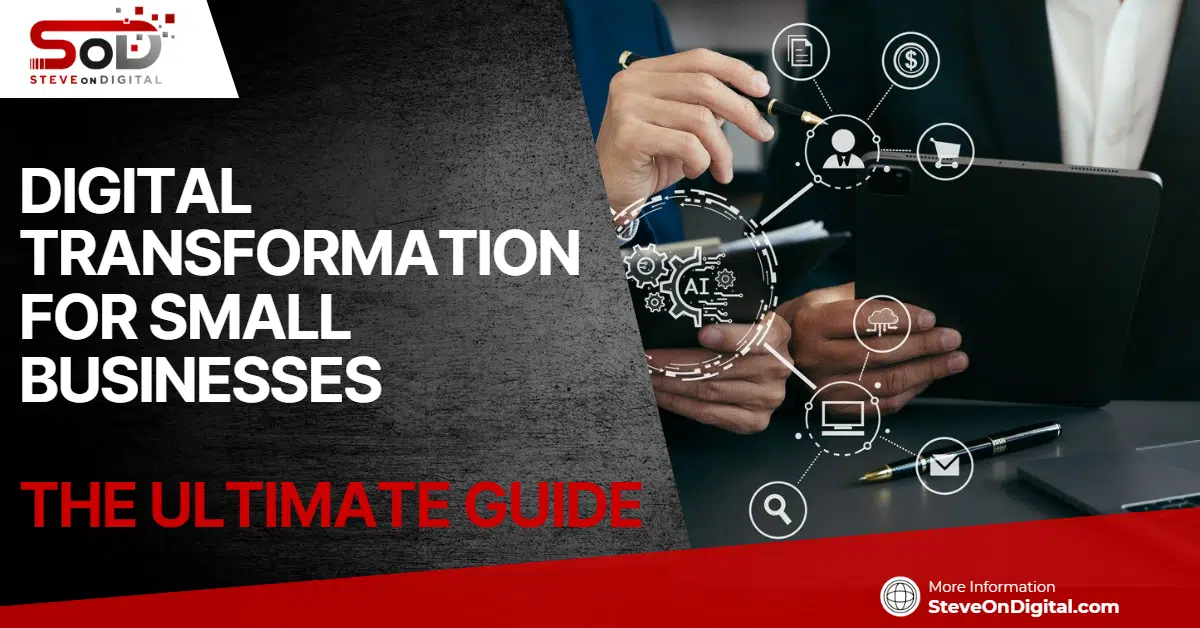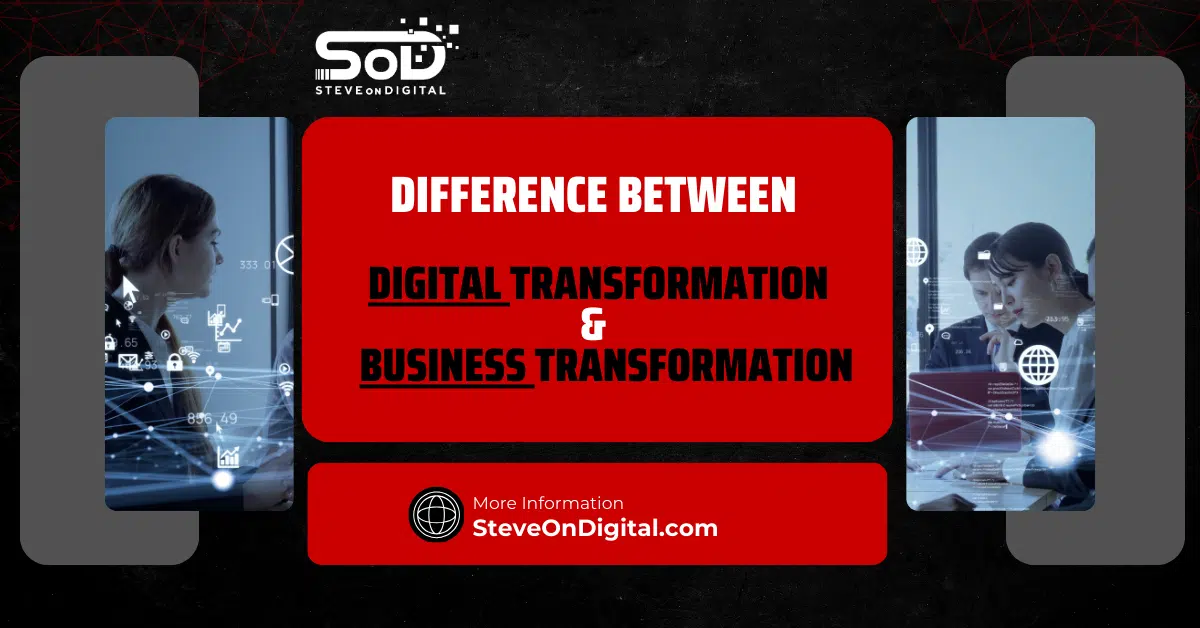Digital transformation for small businesses means using digital technology to improve how you run your business and deliver value to customers. It involves changing business processes, adopting digital tools, and embracing a digital culture.
In this guide, I will explain why digital transformation is crucial for small businesses today. By understanding and implementing these changes, small businesses can improve efficiency, enhance customer experience, and stay competitive in the digital age.
I’m Steve, a digital transformation expert with a strong background in electrical engineering, an MBA, and a master’s in Project Management. I excel at helping SMEs navigate the digital landscape with practical insights. Let’s begin!
Understanding Digital Transformation
What is Digital Transformation?
Digital transformation means using digital technology in every part of a business. It changes how the business works and improves how it serves customers. It’s about more than just adopting new technology; it’s about transforming your business processes and models to thrive in the digital environment.
Key Elements of Digital Transformation
Digital transformation comprises several core components:
- Digital Tools: Using tools like CRM systems, project management software, and cloud-based solutions.
- Digital Data: Leveraging data analytics to make informed decisions.
- Digital Culture: Fostering a culture that embraces change and innovation.
| Element | Description |
|---|---|
| Digital Tools | Tools like CRM systems, project management software, and cloud-based solutions. |
| Digital Data | Leveraging data analytics to make informed decisions. |
| Digital Culture | Fostering a culture that embraces change and innovation. |
Benefits of Digital Transformation for Small Businesses
The advantages of digital transformation are significant:
- Improved Efficiency: Automating manual processes to save time and reduce errors.
- Enhanced Customer Experience: Using digital channels to better understand and meet customer needs.
- Cost Savings: Streamlining operations to reduce costs.
Assessing Your Current Digital Maturity
Evaluating Digital Maturity Levels
Before you can start transforming your business, you need to assess your current digital maturity. This involves looking at how well-integrated digital technologies are in your business processes.
- Criteria and Benchmarks: Compare your current practices against industry standards.
Identifying Gaps and Opportunities
Once you know your digital maturity level, you can identify areas for improvement.
- Spotting Areas for Improvement: Look for gaps where digital tools can enhance efficiency and customer satisfaction.
Developing a Digital Transformation Plan
Setting Clear Objectives and Goals
A successful digital transformation starts with clear objectives.
- Defining Your Vision and Targets: Set specific, measurable goals for what you want to achieve.
Building a Roadmap for Transformation
Creating a detailed roadmap is crucial for guiding your transformation.
- Step-by-Step Guide to Implementation: Outline the steps you need to take, from adopting new technologies to training employees.
Allocating Resources and Budget
Effective resource management ensures that your digital transformation efforts are sustainable.
- Effective Resource Management: Plan your budget and allocate resources efficiently to support your transformation efforts.
Here is a table with the steps and their descriptions:
| Step | Description |
|---|---|
| Setting Objectives and Goals | Define specific, measurable goals for what you want to achieve. |
| Building a Roadmap | Outline the steps you need to take, from adopting new technologies to training employees. |
| Allocating Resources | Plan your budget and allocate resources efficiently to support your transformation efforts. |
Choosing the Right Technology
Digital Tools and Technologies for Small Businesses
Digital transformation for small businesses requires selecting the right digital tools and technologies. From my experience, essential tools include customer relationship management (CRM) systems, project management software, and cloud-based solutions. These tools help streamline operations, improve efficiency, and enhance the customer experience.
Evaluating and Selecting Technologies
Choosing the right technology can be daunting. Here’s a simple approach: first, identify your business needs. Then, research tools that address those needs. Consider factors such as cost, ease of use, integration capabilities, and scalability. Reading reviews and seeking recommendations from peers can also help.
Integrating New Technologies with Existing Systems
Once you’ve chosen the right technology, the next step is integration. It’s vital to ensure that new tools work seamlessly with your existing systems. This minimizes disruptions and maximizes efficiency. Look for technologies that offer robust integration capabilities and provide adequate support during the implementation process.
Enhancing Customer Experience
Understanding Customer Behavior and Expectations
Knowing your customers is crucial. Use data analytics to gain insights into customer behavior and expectations. This helps you tailor your products and services to meet their needs. I’ve found that regularly gathering customer feedback is invaluable for staying informed about their preferences.
Leveraging Digital Channels for Better Engagement
Digital channels like social media, email, and your website are powerful tools for engaging with customers. Social media platforms allow for real-time interaction, while email marketing can be used for personalized communication. Ensure your digital presence is active and responsive to foster stronger customer relationships.
Personalizing Customer Interactions
Personalization can significantly enhance customer experience. Use customer data to offer personalized recommendations and services. For instance, if you run an online store, tailor product suggestions based on past purchases. Personalization makes customers feel valued and understood.
Streamlining Business Processes
Automating Manual Processes
Automation is a game-changer for small businesses. Automating repetitive tasks saves time and reduces errors. Tools like automated invoicing, email marketing automation, and customer service chatbots can handle routine tasks efficiently, freeing up your team to focus on more strategic activities.
Improving Operational Efficiency
Improving operational efficiency is essential for staying competitive. Evaluate your current processes and identify areas where digital tools can make a difference. For example, using digital project management tools can streamline workflows and improve collaboration among your team.
Adopting Cloud-Based Solutions
Cloud-based solutions offer numerous advantages. They provide flexibility, scalability, and cost savings. Cloud storage and computing allow you to access data and applications from anywhere, facilitating remote work and collaboration. In my business, adopting cloud-based solutions has significantly boosted efficiency and operational resilience.
Leveraging Data Analytics
Importance of Data in Digital Transformation
Data is the backbone of digital transformation for small businesses. It serves as a strategic asset that drives decision-making and operational efficiency. By analyzing data, I can uncover patterns and trends that help improve customer interactions and streamline business processes.
Tools and Techniques for Data Analytics
Utilizing the right analytics platforms is crucial. Tools like Google Analytics, Tableau, and Power BI can provide insights into customer behavior and operational performance. These platforms help small business owners make data-driven decisions by visualizing data in an easy-to-understand format.
Making Informed Decisions with Data
Data-driven decision-making is a game changer for businesses. By leveraging data, I can make informed decisions that enhance customer experience, optimize operations, and drive revenue growth. For example, analyzing sales data helps identify top-performing products and customer preferences, enabling more targeted marketing strategies.
Employee Training and Change Management
Importance of Employee Buy-In
Getting employee buy-in is crucial for a successful digital transformation process. Engaging and motivating staff ensures they are on board with the changes. I’ve found that involving employees early and clearly communicating the benefits helps in gaining their support.
Training Programs for Digital Skills
Developing relevant skills and knowledge is essential for digital transformation. Training programs should focus on digital tools, data analytics, and cybersecurity. Providing ongoing education helps employees stay updated with new technologies and best practices, boosting their confidence and productivity.
Managing Change Effectively
Effective change management is key to a smooth transition. Implementing strategies such as regular updates, feedback sessions, and support systems can help manage resistance and ensure a seamless transformation. Sharing success stories and celebrating milestones can also keep the momentum going.
Ensuring Security and Compliance
Understanding Digital Security
Protecting your business and data is paramount in the digital age. Understanding digital security involves knowing the potential threats and vulnerabilities your business might face. It’s essential to implement robust security measures to safeguard your digital environment.
Implementing Security Measures
Best practices for cybersecurity include using strong passwords, enabling two-factor authentication, and regularly updating software. Additionally, training employees on security protocols and recognizing phishing attempts can prevent data breaches. For my business, adopting these practices has significantly reduced security risks.
Compliance with Regulations
Meeting legal and regulatory requirements is critical to avoid penalties and maintain customer trust. Staying informed about regulations such as GDPR or CCPA and ensuring compliance through regular audits and updates is essential. This not only protects your business but also builds credibility with customers.
Measuring Success and Continuous Improvement
Setting Key Performance Indicators
To gauge the success of your digital transformation for small businesses, setting Key Performance Indicators (KPIs) is essential. KPIs provide measurable values that demonstrate how effectively you are achieving your business objectives. Common KPIs include customer satisfaction scores, sales growth, and operational efficiency metrics. By tracking these indicators, I can monitor progress and make informed adjustments to strategies.
Analyzing Results and Feedback
Gathering and analyzing feedback is crucial for continuous improvement. Regularly collecting feedback from customers and employees helps identify areas for enhancement. Tools like surveys and feedback forms can provide valuable insights. In my experience, listening to both positive and negative feedback is key to refining business processes and customer interactions.
Embracing Continuous Improvement
Continuous improvement involves regularly assessing and refining business operations. It’s about adopting a mindset of ongoing optimization. Techniques like the Plan-Do-Check-Act (PDCA) cycle can help systematically improve processes. By embracing continuous improvement, small businesses can remain agile and competitive in a dynamic digital environment.
Common Challenges and How to Overcome Them
Identifying Common Obstacles
Digital transformation can present several challenges for small businesses. Common obstacles include limited budgets, resistance to change, and lack of digital skills. Recognizing these challenges early can help in developing strategies to overcome them.
Strategies for Overcoming Challenges
To tackle these challenges, consider these strategies:
- Budget Constraints: Prioritize investments that offer the highest return on investment.
- Resistance to Change: Communicate the benefits of digital transformation clearly to your team.
- Lack of Skills: Invest in employee training and development.
By implementing these strategies, I’ve seen small businesses navigate through these challenges successfully.
| Challenge | Strategy to Overcome |
|---|---|
| Budget Constraints | Prioritize investments with the highest return on investment. |
| Resistance to Change | Clearly communicate the benefits of digital transformation to your team. |
| Lack of Skills | Invest in employee training and development. |
Case Studies of Successful Digital Transformation
Real-life examples can provide valuable lessons. For instance, a local bakery I worked with embraced digital tools to streamline their ordering process and enhance customer experience. By integrating an online ordering system and leveraging social media for promotions, they saw a significant increase in sales and customer satisfaction. These case studies illustrate the tangible benefits of digital transformation.
Future Trends in Digital Transformation
Emerging Technologies
The digital landscape is continuously evolving with new technologies emerging regularly. Innovations such as augmented reality (AR), blockchain, and the Internet of Things (IoT) are shaping the future of business. Staying informed about these technologies can help small businesses remain relevant and competitive.
Impact of Artificial Intelligence and Machine Learning
Artificial Intelligence (AI) and Machine Learning (ML) are transforming small businesses by automating tasks, providing data-driven insights, and enhancing customer interactions. AI-powered chatbots, for instance, can handle customer inquiries efficiently, freeing up time for more complex tasks. Embracing AI and ML can lead to improved efficiency and better decision-making.
Preparing for the Future
To stay ahead of the curve, small businesses need to be proactive. This involves continuously exploring new technologies, investing in digital skills, and remaining adaptable to change. Preparing for the future ensures that your business can capitalize on new opportunities and address challenges effectively.
Final Thoughts
Summary of Key Points
Digital transformation for small businesses is a multifaceted journey involving technology adoption, process optimization, and cultural change. By understanding the core elements, leveraging data analytics, choosing the right technologies, and focusing on continuous improvement, small businesses can thrive in the digital age.
Encouragement to Start the Digital Transformation Journey
Starting a digital transformation journey can seem daunting, but the rewards are well worth the effort. By taking small, strategic steps and continuously learning and adapting, any small business can achieve a successful digital transformation. I encourage you to embrace this journey and unlock the full potential of your business in the digital era.




